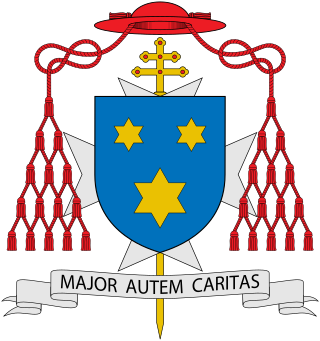
Pope Clement XII, born Lorenzo Corsini, was head of the Catholic Church and ruler of the Papal States from 12 July 1730 to his death in February 1740.

Pope Urban VII, born Giovanni Battista Castagna, was head of the Catholic Church, and ruler of the Papal States from 15 to 27 September 1590. His thirteen-day papacy was the shortest in history.

Pope Innocent IX, born Giovanni Antonio Facchinetti, was head of the Catholic Church and ruler of the Papal States from 29 October to 30 December 1591.

Pope Innocent XII, born Antonio Pignatelli, was head of the Catholic Church and ruler of the Papal States from 12 July 1691 to his death in September 1700.

Monsignor is an honorific form of address or title for certain male clergy members, usually members of the Roman Catholic Church. Monsignor is the apocopic form of the Italian monsignore, meaning "my lord". "Monsignor" can be abbreviated as Mons or Msgr. In some countries, the title "monsignor" is used as a form of address for bishops. However, in English-speaking countries, the title is dropped when a priest is appointed as bishop.
In the Roman Curia, a congregation is a type of department of the Curia. They are second-highest-ranking departments, ranking below the two Secretariats, and above the pontifical councils, pontifical commissions, tribunals and offices.
The Roman Rota, formally the Apostolic Tribunal of the Roman Rota, and anciently the Apostolic Court of Audience, is the highest appellate tribunal of the Catholic Church, with respect to both Latin-rite members and the Eastern-rite members and is the highest ecclesiastical court constituted by the Holy See related to judicial trials conducted in the Catholic Church. An appeal may be had to the pope himself, who is the supreme ecclesiastical judge. The Catholic Church has a complete legal system, which is the oldest in the West still in use. The court is named Rota (wheel) because the judges, called auditors, originally met in a round room to hear cases. The Rota was established in the 13th century.
The papal household or pontifical household, called until 1968 the Papal Court, consists of dignitaries who assist the pope in carrying out particular ceremonies of either a religious or a civil character.

In the Roman Catholic Church, protonotary apostolic is the title for a member of the highest non-episcopal college of prelates in the Roman Curia or, outside Rome, an honorary prelate on whom the pope has conferred this title and its special privileges. An example is Prince Georg of Bavaria (1880–1943), who became in 1926 Protonotary by papal decree.
The Prefecture of the Papal Household is the office in charge of the Papal Household, a section of the Roman Curia that comprises the Papal Chapel and the Papal Family.
The Supreme Tribunal of the Apostolic Signatura is the highest judicial authority in the Catholic Church. In addition, it oversees the administration of justice in the church.
Doctor of Canon Law is the doctoral-level terminal degree in the studies of canon law of the Roman Catholic Church. It can also be an honorary degree awarded by Anglican colleges. It may also be abbreviated ICD or dr.iur.can., ICDr, DCL, DCnl, DDC, or DCanL. A doctor of both laws is a JUD or UJD.
The Apostolic Camera, formerly known as the Papal Treasury, was an office in the Roman Curia. It was the central board of finance in the papal administrative system and at one time was of great importance in the government of the States of the Church and in the administration of justice, led by the Camerlengo of the Holy Roman Church, originally known as camerarius (chamberlain).
In legal terminology, a rescript is a document that is issued not on the initiative of the author, but in response to a specific demand made by its addressee. It does not apply to more general legislation.
The Preacher of the Papal Household, also known as the Apostolic Preacher, is an office in the Roman Curia. This individual provides meditation to the pope as well as other senior officials of the Catholic Church while being the only cleric allowed to preach to the Pope. Since 1980, the position has been held by Raniero Cantalamessa, of the Order of Friars Minor Capuchin.

Francesco Roberti was an Italian cardinal of the Roman Catholic Church. He served as prefect of the Apostolic Signatura in the Roman Curia from 1959 to 1969, and was elevated to the cardinalate in 1958. He was also known for his work in moral theology.

Francesco Morano was an Italian Cardinal of the Roman Catholic Church. He served as Secretary of the Apostolic Signatura in the Roman Curia from 1935 until 1959, and was elevated to the cardinalate in 1959.

Giovanni Battista de Luca (1614–1683) was an Italian jurist and Cardinal of the Roman Catholic Church.

The history of the Roman Curia, the administrative apparatus responsible for managing the affairs of the Holy See and the Catholic Church, can be traced to the 11th century when informal methods of administration began to take on a more organized structure and eventual a bureaucratic form. The Curia has undergone a series of renewals and reforms, including a major overhaul following the loss of the Papal States, which fundamentally altered the range and nature of the Curia's responsibilities, removing many of an entirely secular nature.
In the canon law of the Catholic Church, a notary is a person appointed by competent authority to draw up official or authentic documents. These documents are issued chiefly from the official administrative bureaux, the chanceries; secondly, from tribunals; lastly, others are drawn up at the request of individuals to authenticate their contracts or other acts. The public officials appointed to draw up these three classes of papers have been usually called notaries.









